Hedgehog (Hh) signal pathway is a signal pathway that transmits information to embryonic cells for appropriate cell differentiation. Specifically, Hedgehog signaling pathway is one of the key regulators of animal development. There are three mammalian Hh proteins, Shh, Indian hedgehog (IHH), and desert hedgehog (DHH). Besides, Shh and IHH have important and sometimes overlapping functions in several organizations. Moreover, Shh plays a particularly significant role in the standardization of cell types in the nervous system and the patterning of limbs. IHH plays an important role in bone development (mainly endochondral ossification).
As a precursor molecule, HH protein is composed of the C-terminal protease domain and N-terminal signal unit. In the presence of an active HH ligand, the binding of HH to its receptor PTC will release this inhibition. This allows SMO to signal downstream, eventually leading to the activation of the Gli transcription factor. Furthermore, the Hedgehog signal plays a role in regulating adult stem cells involved in adult tissue maintenance and regeneration. This pathway is also associated with the development of some cancers. Meanwhile, Targeted inhibition of Hh signaling may be effective in the treatment and prevention of many types of human cancers. Nonetheless, the discovery and synthesis of specific Hh pathway inhibitors have important clinical significance for new cancer treatment. Today, we will introduce a Hedgehog (Hh) pathway antagonist, Cyclopamine.

Cyclopamine is a Hedgehog (Hh) Pathway Antagonist.
First of all, Cyclopamine has an IC50 of 46 nM in the Hh cell assay. Cyclopamine is also a selective Smo inhibitor. Small molecule Hh inhibitors, binding to Smo, induce tumor remission in a genetic mouse model of medulloblastoma. Obviously, Cyclopamine suppresses cell growth. Particularly, Cyclopamine with 3 μM suppression of Hh pathway activity and growth in digestive tract tumor cell lines correlates with expression of PTCHmRNA. Importantly, Cyclopamine is a steroidal alkaloid that inhibits Hh signaling through direct interaction with Smo.
Additionally, Cyclopamine causes durable regression of xenograft tumors. Tumors in Cyclopamine-treated animals regress completely by 12 days. Interestingly, Cyclopamine (1.2 mg) treatment blocks tumor formation of human pancreatic adenocarcinoma cells after transplantation into nude mice.
References:
Berman DM, et al. Nature, 2003, 425(6960), 846-851.